外研版(2019)选择性必修 第三册Unit 1 Face values Using language(2)课件(共11张PPT)
文档属性
| 名称 | 外研版(2019)选择性必修 第三册Unit 1 Face values Using language(2)课件(共11张PPT) |
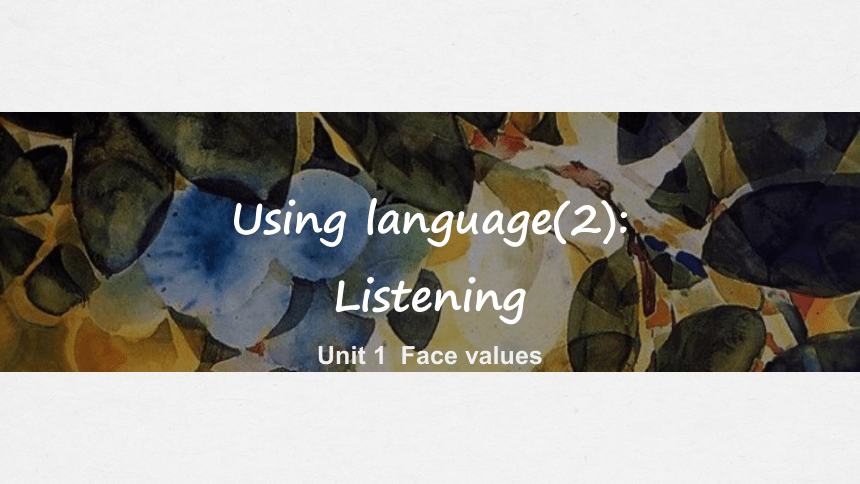
|
|
| 格式 | pptx | ||
| 文件大小 | 13.8MB | ||
| 资源类型 | 教案 | ||
| 版本资源 | 外研版(2019) | ||
| 科目 | 英语 | ||
| 更新时间 | 2024-04-27 22:59:15 | ||
图片预览

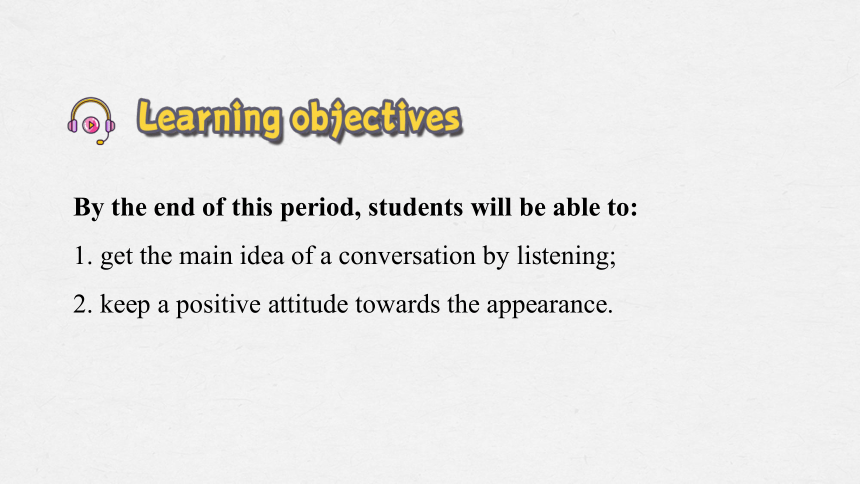
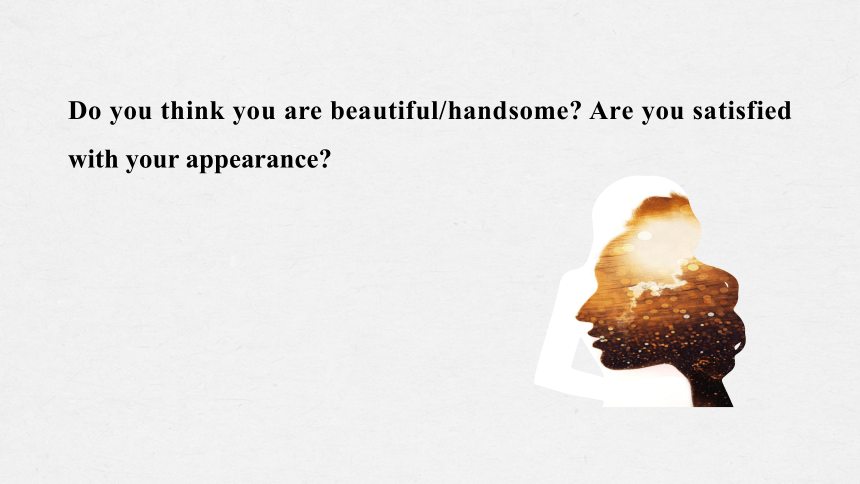
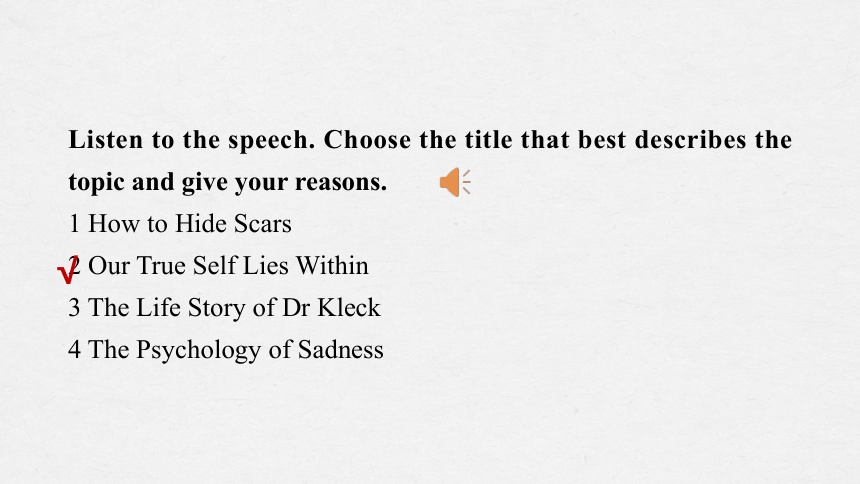
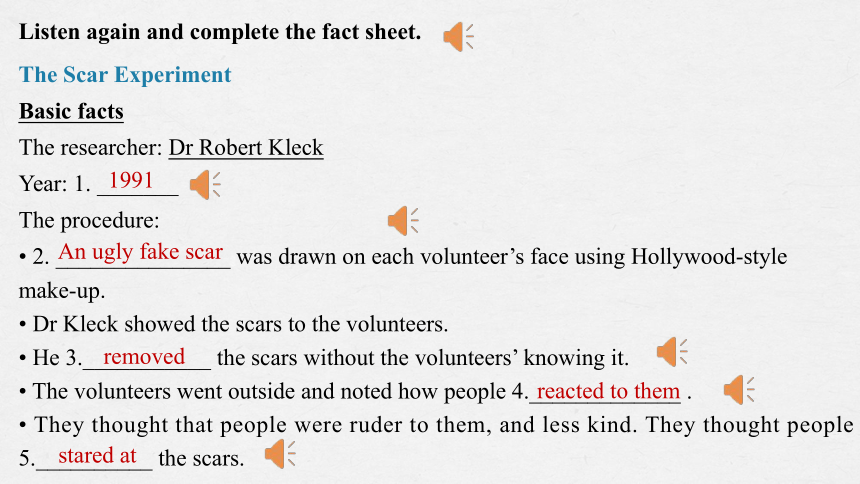
文档简介
(共11张PPT)
Using language(2):
Listening
Unit 1 Face values
By the end of this period, students will be able to:
1. get the main idea of a conversation by listening;
2. keep a positive attitude towards the appearance.
Do you think you are beautiful/handsome Are you satisfied with your appearance
Listen to the speech. Choose the title that best describes the topic and give your reasons.
1 How to Hide Scars
2 Our True Self Lies Within
3 The Life Story of Dr Kleck
4 The Psychology of Sadness
√
Listen again and complete the fact sheet.
The Scar Experiment
Basic facts
The researcher: Dr Robert Kleck
Year: 1. _______
The procedure:
2. _______________ was drawn on each volunteer’s face using Hollywood-style
make-up.
Dr Kleck showed the scars to the volunteers.
He 3.___________ the scars without the volunteers’ knowing it.
The volunteers went outside and noted how people 4._____________ .
They thought that people were ruder to them, and less kind. They thought people 5.__________ the scars.
1991
An ugly fake scar
removed
reacted to them
stared at
Findings
The volunteers 6._____________________ others’ behaviour towards them.
Who we are is in our heads, not 7._______________________ .
If people choose to feel 8._________________, they will actually feel that way.
imagined/misunderstood
how we look on the outside
happy and positive
Now give a short introduction to the experiment using the information in the fact sheet.
Hello, and thank you for coming. The subject of this speech is self-image, that is, your opinion of your own appearance, abilities, and personality. As we know, psychologists often perform experiments to learn more about human character and behaviour. Today, I’m going to talk about a psychological experiment from 1991. It’s called the Scar Experiment.
This experiment was created by a psychologist called Dr Robert Kleck. First, he found ten volunteers and put each of them into a different room without mirrors. Next, he drew an ugly fake scar on each volunteer's face using make-up—the sort of make-up they use in Hollywood films.Then he took out a mirror and showed the volunteers their scars. Next, Dr Kleck pretended to improve the scars, but actually removed the make-up. So the volunteers thought they had scars, but they didn’t.
Listen again and read it aloud.
After that, the volunteers were told to go outside, and take note of how people reacted to them. They did this, and came back. They all reported that people were ruder and less kind to them, and that people stared at their scars. As a result, they felt very uncomfortable. However, they didn’t really have scars! The volunteers imagined that other people had changed their behaviour, but actually they had not.
As you can see, there’s an important lesson here. It doesn’t matter how we actually look—the only thing that’s important is how we feel about ourselves.
To sum up, who we are is in our heads. It’s not how we look on the outside that matters, but how we feel on the inside. If we choose to be happy and positive, then we will feel that way. If we show a happy and positive face to the world, we will get one back in return.
I hope you’ve enjoyed the speech. Thank you, and remember: your true self lies within.
Work in pairs and discuss the questions.
1. What can you learn from the Scar Experiment
2. Does your appearance influence how you feel inside
THANKS
Using language(2):
Listening
Unit 1 Face values
By the end of this period, students will be able to:
1. get the main idea of a conversation by listening;
2. keep a positive attitude towards the appearance.
Do you think you are beautiful/handsome Are you satisfied with your appearance
Listen to the speech. Choose the title that best describes the topic and give your reasons.
1 How to Hide Scars
2 Our True Self Lies Within
3 The Life Story of Dr Kleck
4 The Psychology of Sadness
√
Listen again and complete the fact sheet.
The Scar Experiment
Basic facts
The researcher: Dr Robert Kleck
Year: 1. _______
The procedure:
2. _______________ was drawn on each volunteer’s face using Hollywood-style
make-up.
Dr Kleck showed the scars to the volunteers.
He 3.___________ the scars without the volunteers’ knowing it.
The volunteers went outside and noted how people 4._____________ .
They thought that people were ruder to them, and less kind. They thought people 5.__________ the scars.
1991
An ugly fake scar
removed
reacted to them
stared at
Findings
The volunteers 6._____________________ others’ behaviour towards them.
Who we are is in our heads, not 7._______________________ .
If people choose to feel 8._________________, they will actually feel that way.
imagined/misunderstood
how we look on the outside
happy and positive
Now give a short introduction to the experiment using the information in the fact sheet.
Hello, and thank you for coming. The subject of this speech is self-image, that is, your opinion of your own appearance, abilities, and personality. As we know, psychologists often perform experiments to learn more about human character and behaviour. Today, I’m going to talk about a psychological experiment from 1991. It’s called the Scar Experiment.
This experiment was created by a psychologist called Dr Robert Kleck. First, he found ten volunteers and put each of them into a different room without mirrors. Next, he drew an ugly fake scar on each volunteer's face using make-up—the sort of make-up they use in Hollywood films.Then he took out a mirror and showed the volunteers their scars. Next, Dr Kleck pretended to improve the scars, but actually removed the make-up. So the volunteers thought they had scars, but they didn’t.
Listen again and read it aloud.
After that, the volunteers were told to go outside, and take note of how people reacted to them. They did this, and came back. They all reported that people were ruder and less kind to them, and that people stared at their scars. As a result, they felt very uncomfortable. However, they didn’t really have scars! The volunteers imagined that other people had changed their behaviour, but actually they had not.
As you can see, there’s an important lesson here. It doesn’t matter how we actually look—the only thing that’s important is how we feel about ourselves.
To sum up, who we are is in our heads. It’s not how we look on the outside that matters, but how we feel on the inside. If we choose to be happy and positive, then we will feel that way. If we show a happy and positive face to the world, we will get one back in return.
I hope you’ve enjoyed the speech. Thank you, and remember: your true self lies within.
Work in pairs and discuss the questions.
1. What can you learn from the Scar Experiment
2. Does your appearance influence how you feel inside
THANKS
